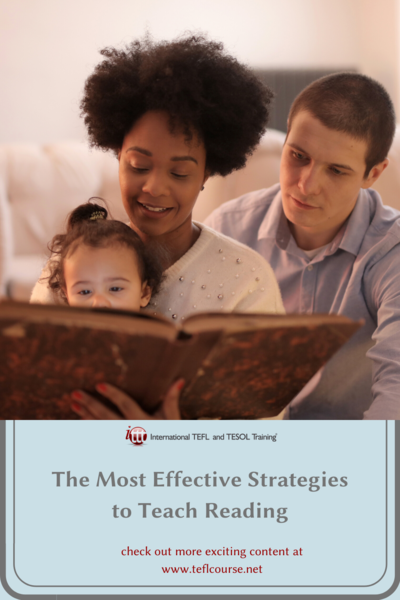The Most Effective Strategies to Teach Reading

Reading competence involves making sense of the written text and requires the complex interaction of knowledge and skills. When children learn to read, they need to learn to integrate the use of visual, phonological and semantic cues and relate to their own experience to construct meaning. An effective reading instruction thus involves a combination of phonological instruction (decoding) and whole language (reading for meaning), with the use of authentic literary experience. This paper will provide a summary of essential areas of reading instruction, coupled with various strategies that I have used in my work as an educational psychologist and teacher, helping young children to read.
Table of Contents
Do you want to teach English abroad? Take a TEFL course!
This post was written by our TEFL certification graduate Pearly T. Please note that this blog post might not necessarily represent the beliefs or opinions of ITTT.
As a start, it important to take an ecological perspective where it is necessary to provide a literate and print-rich external environment for the children.
For example, labeling the classroom furniture, making a chart of key instructions and a display of famous people and places. To promote reading skills, teachers should also provide regular shared reading aloud activities with the children for them to become familiar with conventions of print and text. Specifically, teachers should read aloud with the children as the latter follow pictures and text in storybooks. Furthermore, fun and engaging activities to develop skills at letter, word, sentence and text level could be provided to stimulate children's interest in learning to read (Read, 2007). Also, specific strategies and processes in reading should be provided to develop skilled readers who will read purposefully (Mercer, 1997; Palinscar & Brown, 1986). Two strategies will be provided later in the paper.
Several decades of research on reading instruction (National Institute of Child Health and Human Development, 2000) also clearly shows that effective reading instruction addresses five essential areas namely, phonics, phonemic awareness, fluency or automaticity, vocabulary, and comprehension. Children with reading difficulties or are at-risk of reading failure tend to have problems arising from these critical areas and require explicit instruction (Foorman, Francis, Fletcher, Schatshneider & Mehta, 1998; Wolf, 1999).
Also Read: 3 Essential Reasons for Establishing Rapport in the EFL CLassroom
Phonics
Phonics can be defined as a set of rules that specify the relationship between letters in the spelling of words and sounds of the spoken language. Phonics instruction is intended to help young learners to understand and use the alphabetic principle. Specifically, students learn to recognize unfamiliar words by associating speech sounds with letters or groups of letters.
Phonics instruction should be explicit and systematic. The teacher is required to explain clearly and directly that certain letters or letter combinations represent certain sounds. There are vowel sounds, consonant sounds, consonant blends, and digraphs and diphthongs (Ekwall & Shanker, 1993). One activity that I often used in teaching is called the visual drill where students are taught letter names and letter-sound correspondence. Such a multisensory technique is useful for young learners.* Step 1 The Teacher first shows the target letter d.* Step 2 Teacher then says letter name and letter sound, simultaneously tracing letter in the air.* Step 3 Students repeat letter name and sound and trace similarly.
The National Reading Panel of the USA strongly recommends that phonics be included as a component of reading instruction. Systematic phonics instruction has been shown to produce substantial improvement in reading through sixth grade and effects were greater for younger kindergarten pupils and pupils at risk of future reading failure(NICHD,2000). It is important to be aware that phonics instruction is a means to an end, meaning that the lesson should progress from recognizing letter-sound relationships to using these relationships to read decodable connected text.

Also Read: What is the difference between TESOL and TEFL
Phonemic awareness
Prevention and intervention studies have converged on the importance of phonological awareness in learning to read (Adams, 1990; Bennett & Ottley, 2000). There are various levels of phonological awareness that needs to be taught from the easiest level: segmenting sentences into words; segmenting words into syllables; identifying words that rhyme; segmenting words into onset and rime to the most difficult and complex task of phonemic awareness. The reading process involves the reader translating "graphemes into phonemes and then blending the phonemes to form words with recognizable meanings" (NICHD, 2000, p. 2-11). Thus, phonemic awareness is a critical skill in learning to read.
Phonemic awareness is defined as the ability to focus and manipulate phonemes (separate units of sounds) in spoken words. For example, asking participants how many sounds or phonemes do they hear in the word "cat"? Recognizing the cat has three sounds /k//a//t/ is an example of phonemic awareness skill. The following activity could be used for the teaching of phonemic identification, segmentation, and blending.* Step 1 Tell the student the new target sound /a/* Step 2 Teacher models in saying the sound, highlighting the shape of the mouth, position of the tongue and lower jaw.* Step 3 Show a picture that begins with /a/ such as ant; name it and say it begins with /a/* Step 4 The Teacher guides pupils to segment the individual sounds /a//n//t/ with the use of 3 magnetic tokens. The teacher points to each token as each sound is made.
Phonemic awareness helps young children to use more advanced ways of learning new words. Learning a new word involves forming connections between the visual information about the word as it appears in print and its meaning, pronunciation and other information stored in a child's oral vocabulary. Because the English system is based on the representation of phonemes (individual speech sounds) by graphemes (letters and letter combinations), pupils who have developed phonemic awareness have an easier time recognizing unfamiliar words in print.
Fluency
Fluency is recognizing words in a text rapidly and accurately and using phrasing and emphasis in a way that makes what is read sound like spoken language. A large scale study of fluency in the USA (Pinnell, Pikulski, Wilson, Campbell, Gough & Beatty, 1995) discovered a close relationship between fluency and comprehension. Pupils low in fluency also showed difficulty in comprehending what they read. This is because the reading process involves two cognitive tasks: recognizing printed words (decoding) and constructing meaning from the recognized words (comprehension). The amount of cognitive resources for these two tasks is restricted by the limits of memory. If there is no fluency in word recognition for non-fluent readers, there are limited cognitive resources for interpretation of meaning (Hooks & Jones, 2002). Thus automaticity in word recognition or fluency is encouraged.
The practice is a key component in acquiring automaticity or fluency. Repeated reading can be used to enhance fluency. Repeated oral reading (around four times) can be used by asking pupils to read and reread a passage or story. The teacher first begins reading orally, pointing to each word as it is read and then pupils read along. The teacher then fades out in the reading. When the pupils can read 60 words correct per minute, a new text can be used.
Another technique that has been used in my teaching practice is precision monitoring to build fluency in recognition of regular and irregular words learned.
- Step 1 The Teacher first chooses 5 words and then prepares a 10x5 grid probe sheet. The 5 words are randomly distributed in each row in the probe sheet. Each word is repeated 10 times.
- Step 2 Teacher tells pupils that the goal is to read 50 words correctly per minute
- Step 3 The Teacher helps pupils to correct mistakes and set goals for the next session until fluency is achieved.Besides fluency, another important area is vocabulary instruction as a component in reading.
Also read: 5 Creative Writing Activities for the ESL Classroom
Vocabulary
Vocabulary is important for reading to learn and learning to read. Children need to understand the meanings of the words they read. Young readers use the pronunciations and meanings of words in their oral vocabulary to help them recognize the words they see in print. When children sound out an unfamiliar word, they use the trial pronunciation they have created to search their oral vocabulary. Picture cards and word searches can be used to enhance vocabulary.

Comprehension
Comprehension involves constructing meaning that is reasonable and accurate by connecting what has been read to what the reader already knows and thinking about all of this information until it is understood. Comprehension is the final goal of reading instruction.
To improve reading comprehension, a reciprocal teaching strategy can be used. It is an interactive teaching strategy that uses teacher-student dialogue to enhance comprehension of text and monitoring of understanding. There is active participation in text discussion (Palinscar & Brown, 1986). Reciprocal teaching strategy involves four stages.* Stage 1 Predicting where students make predictions about upcoming content from cues and structures of the text. They then proceed to read to disapprove or confirm their prior hypotheses about the text.* Stage 2 Question generating where the teacher models and provides guided practice for students to generate main idea questions about the text.* Stage 3 Summarizing where students integrate information* Stage 4 Clarifying stage where students clear doubts with teachers and rereading for greater understandingI often use this technique with older students.
For younger kids, a story map strategy can be used. A story map is used as an organizer for readers and students are asked to fill map components as they read (Idol & Croll, 1987). The map components of a narrative story include setting (characters, time, place), problem, goal, action, and outcome). The teacher starts by modeling the use of a story map by highlighting the components. The students then complete the task independently. Improved comprehension results as the students have a structure to understand, conceptualize and remember the story.
Do you want to teach English abroad? Take a TEFL course!
In summary, the five essential components of reading (phonics, phonemic awareness, fluency, vocabulary and comprehension) represent important ingredients for teaching children to learn to read. Lesson plans should include engaging activities that blend the five components in various proportions along with the use of explicit and structured teaching strategies to meet the individual needs of the child to promote reading. All these coupled with the provision of a print-rich environment and opportunities for shared reading are needed to develop competent readers.
Apply now & get certified to teach english abroad!
Speak with an ITTT advisor today to put together your personal plan for teaching English abroad.
Send us an email or call us toll-free at 1-800-490-0531 to speak with an ITTT advisor today.
Related Articles:
- The 10 Best Destinations for Teaching English Abroad in 2018
- The How-To Guide for Americans to Teach English in Europe
- 5 Great Places to Teach English Abroad Without a Degree
- Top 10 Cities in Europe with the Highest Demand for English Language Teachers
- Top 10 Places to Take Your TEFL Course in Winter
- Top Tips for Teaching English in Europe




